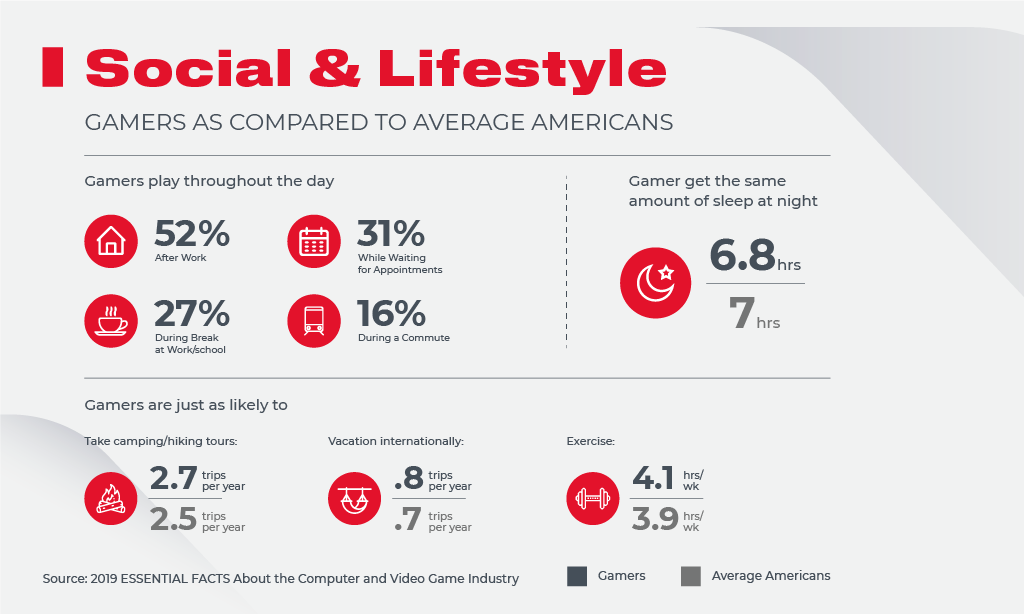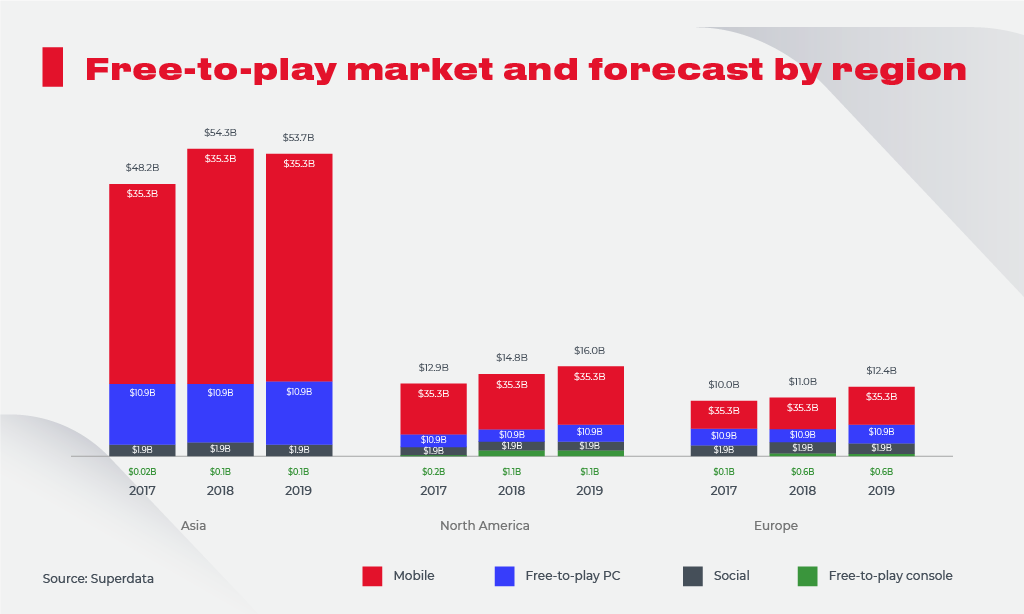Why Gaming Culture is Vital For Building Effective Gaming Business
The gaming culture is developing so rapidly that studies state the industry is going to hit the recording US$300 billion in the next 5 years. The number of players around the world has reached 2.5 billion, meaning that every third person on Earth plays some kind of game.
The gaming sector attracts more and more users. Some want to get a fascinating in-game experience, while others strive to build a revenue-generating gaming business. To understand what draws people into this area, you need to delve a little into gaming culture and historical facts.
Gaming Culture and Lifestyle: The Average Gamer Lives A Healthy Life
The statistics show that people have been playing since 2006 every day. Generations grew up with the evolution of games. Just as video games have transformed into more vibrant, sophisticated, and more comprehensive creations, the players’ associations have become more inclusive and accessible as well.
Modern gamers are completely different representatives of the population which can be distinguished by age, gender, and ethnicity. In the, US for example, the gaming audience, consisting of 54% of men and 46% of women, are people who have a healthy lifestyle, are easy-going, and lead an active social life.

The study unveils astonishingly positive results towards gamers’ behavior. Individuals report that they get mentally stimulated, relaxed, and relieved from stress during their gaming activity.
Modern families are often in the mood for games, sharing that video games can be educational for their children (74% of parents). At the same time, almost 60% of adults enjoy playing together with their kids at least once a week. Let’s find out how the games evolved and what led to what they are now.
Gaming Culture: Historical Background and Terminology
The very first video games were made solely for one player, were console-based, and mostly had a story plot. These games comprised fabulous elements that would draw players into the process, just like adventure fiction would immerse passionate readers.
Although there were attempts to add internet capabilities to console games by the end of the 1990s, the first online console games appeared with Xbox Live in 2002. The first multiplayer genres emerged as well, such as Starcraft or Counter-Strike.
The common types of online multiplayer games are:
- MMOs (massively multiplayer online games) involve huge numbers of gamers who play on the same server.
- MMORPGs (massively multiplayer role-playing games) have plenty of participants, and an authentic virtual world, which continues to exist even when a player is out of the game.
- RPGs (role-playing games) imply playing a certain character in a virtual world and controlling most of their movements.
- FPSs (first-person shooters) are focused on fighting with enemies using various weapons in the first person.
- Strategy video games are centered on designing a strategic plan to take a win. The other subdivision of the genre may include real-time strategies (RTS), multiplayer online battle arena (MOBA), and more.
- Battle royale games are survival games where players combat in ever-shrinking arenas, collect various weapons, and desperately fight until the last gamer is left on a battlefield.
Also, online games with multiple players split into two categories: PvE (Player vs. Environment) and PvP (Player vs. Player). The PvP type is common for MMORPGs or certain shooters where participants work synchronically to combat rivals. Strategic video games, FPS, and battle survival games are representatives of the PvE type. There are of course games with mixed capabilities.
One more classification exists, offering a conceptual view with the cross-section of games by the level of complexity and the extent of social interaction required, with examples attached to each category.

The monetization of the games has also changed dramatically over the last decades. In early times, players could purchase the entire game with all embedded content. Nowadays, most online games have a free-to-play model with paid in-game items, which can add extra functionality, boost your power, unlock the next level, and more.
Such accessibility inspired even more people to play games, especially well-known Dota Underlords, Star Wars, or World of Tanks. Moreover, a free-to-play model became a beneficial business solution on the market, which has already spread to the mobile sector.
Gaming Business: Revenue Shifts of The Industry
Besides the remarkable and persistent growth of the industry, it is important to pay attention to the new revenue shifts in the gaming business. While publishers made money from games’ purchases in the past, they now release them for free. We have already mentioned one popular business model. Let’s look at the emerged income sources, allowing you to get paid easier than ever.
Free-to-Play Games with Paid Content
Currently, the free-to-play (F2P) games rule the industry. They appeared to be the most profitable, notwithstanding the users don’t have to pay to start a game. According to the SuperData’s report, F2P games made a staggering US$88 billion in 2018, leaving traditional games in the dust.
The report also estimates the total gaming market makings comprise mind-blowing US$110 billion, more than US$61 billion generated from mobile platforms, where major F2P games are concentrated.

For example, the Fortnite’s income is US$2.4 billion, where more than one billion was made thanks to the purchases of in-game items. This tendency resulted in a global switch to the F2P business model.
Games with Paid Content Provided by Third-Parties
The appearance of subscription streaming games such as Xbox Game Pass or PlayStation Now involves even more customers into the niche. Currently, players spend over 7 hours per week on their favorite games. This figure can be twice as large by 2021 with the development of cloud gaming.

Following the F2P trend and the rise of subscription-based games, the developers seek alternative revenue sources. Thus, while one game companies design in-game commercial content for themselves, the others hire third-party providers. This business solution is not widespread yet, but can dramatically evolve in several years.
The DMarket provides a broad spectrum of accessories for gamers. There you can not only buy but also sell and trade these in-game elements securely. This way, developers draw and keep a larger number of gamers while getting paid faster and more. Meanwhile, players can gain profits too by exchanging items between other counterparts.

Such third-party platforms fuel the gaming market evolution and enable players to boost their in-game capabilities significantly. It’s hard to imagine a person who can resist a compelling playing experience and the opportunity to do business.
5 Step Guide to Launch Gaming Business
Gaming business ideas don’t cost a penny until implemented in life. If you are sure this economic sector is your cup of tea, grab this guide to get started and make the most out of your business adventure.
1. Create a Plan to Run a Successful Business
Writing a business plan with specific goals and techniques is a stepping stone to start a gaming business. This plan should contain information on what games you want to build, their monetization model, upfront costs, licenses, and legal permits.
Also, identifying your target audience (TA) plays a pivotal role in making money from your video game on a regular basis. In addition, you need to define the organization type – whether you want to run individual entrepreneurship or general partnership, get these things done.
2. Ensure You Stay with Law
To run a gaming company, entrepreneurs first need to get their federal and state tax ID numbers, register for a sales tax permit, so that tax collection is smooth and you don’t have to worry about any illegal issues. If you know the name of the organization you want to operate, register it in an appropriate state department as well.
There are strict government regulations regarding running gambling firms such as casinos. That’s why you have to stay with the law and obtain a specific gambling license for you and for your workers. Registering your trademark or copyright is very crucial to advocate your original ideas if you create a unique product.
3. Pick a Reliable IT Partner
After finishing all financing and compliance procedures, it’s high time to find a trusted IT gaming development company to create your game from scratch. Normally, third-party IT vendors provide a full-cycle software solution suitable for your business needs. They build a secure platform with a content management system (CMS), player management panel, billing system interface, technical assistance, and interactive design many more.
5. Plan Smart Game Promotion
Depending on the game type you want to deal with, you need to plan your promotions and advertising initiatives.
Employ social media channels to find gamers communities, communicate with potential users, and probably find the game buyers. Profiles on Facebook, Instagram, YouTube, or Twitter will be excellent pathways to promote your game to a vast audience. Besides, you can create the website optimized for SEO that can be your online business card.
Summary: Be Ready To Start a Gaming Business Seamlessly
To dive deep into gaming business and run it successfully, there is a certain need to be a real expert. First, try to get some insights from gaming culture, find out demographic specifics to better know the TA, define the suitable type of game to develop and the monetization model. Hopefully, our findings will help start a gaming business.
The takeaways of the article:
- The gamers are split almost fifty-fifty into males and females.
- Adults with pleasure play games accompanying their children to stay aware of their preferences.
- Players live healthily and are more socially active compared to those who don’t play.
- Players travel a lot, do sports, but sleep fewer hours.
- Multiplayers games have been growing since the early 2000s.
- Free-to-play (F2P) games became an industry-leading business model.
- The trade of game content is growing to attract more and more people to play and earn money.
- To start a gaming business, one needs a thorough plan.